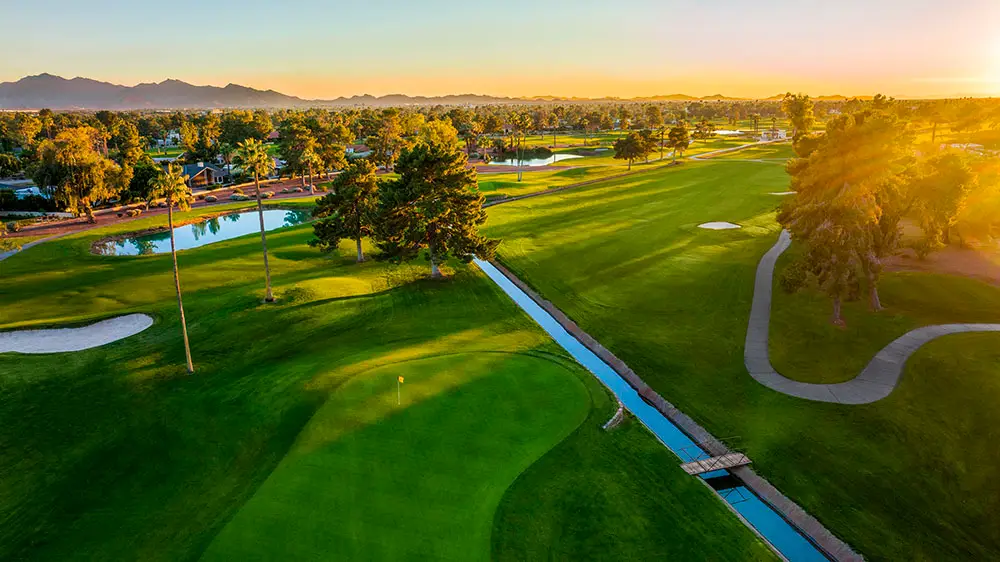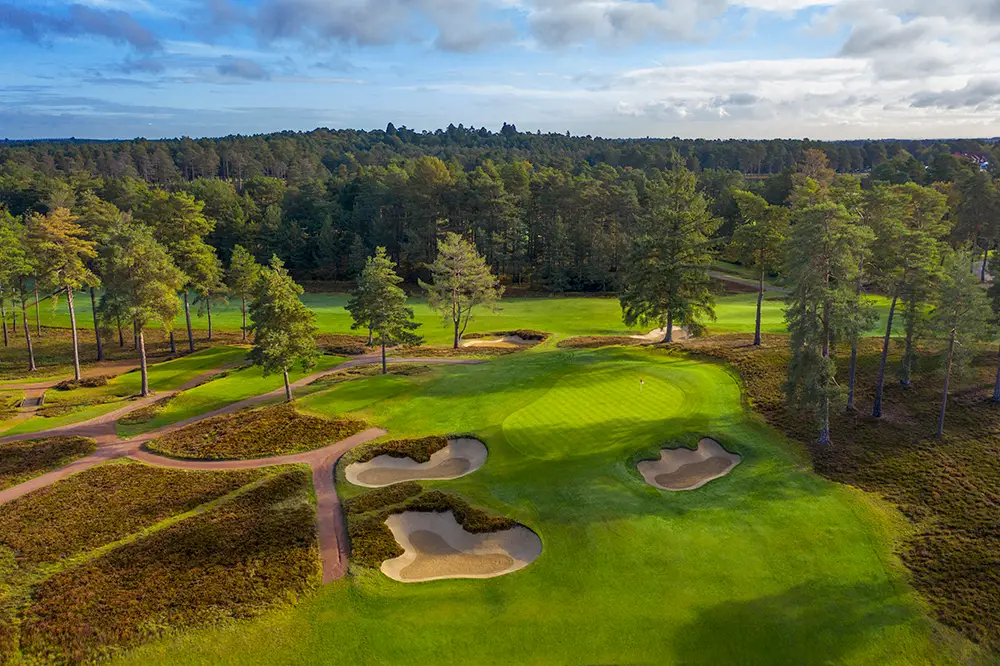When it comes to naming golf courses, there’s no shortage of popular categories. While we love a clever or dramatic name as much as the next guy, there’s also a place for simplicity; and when it comes to simple yet effective names, the color spectrum leads the way. With that in mind, we’ve highlighted six noteworthy golf properties that are famous for their color-coded courses.
Bethpage State Park (Farmingdale, N.Y.)
It’s only appropriate that we start with Bethpage, as the Long Island state park is famous for its Black course; however, slews of amateurs who have tested their mettle there would likely say that the Tillinghast design is perhaps more infamous than famous. While the Black was designed and built in 1936 to be the ultimate test of golf—Rees Jones even speculates that it was Tillinghast’s response to Pine Valley, circa 1918—there are four other color-coded courses at the park that understandably fly a bit under the radar. The Red course, according to one Bethpage regular, is the layout that most in-the-know golfers seek to play most of the time, though it’s a stout test with tree-lined doglegs and a collection of long par fours that play across wind-swept flatlands. The Blue course demands great golf right out of the chute with its front nine punctuated by blind shots, concealed landing areas, and elevated greens; however, those who survive the outward holes are rewarded with a stretch of shorter holes that meander across flatter terrain. Some would argue that the Yellow course, a creation by Alfred Tull in 1958, is underrated, as it’s a layout that embraces creativity and allows golfers to hit a variety of shots both off the tee and into the greens. Finally, the Green course, which abuts the Black, shares some of the same hilly terrain, though repeat visitors to the park will tell you that it’s the one course out of the five that feels like it exists in its own separate world.

The Wigwam Resort (Litchfield, Ariz.)
The Wigwam Resort just west of downtown Phoenix is proof that three courses built across the same parcel of land can deliver distinct playing experiences, even if they offer limited diversity in appearance. Originally designed by Robert Trent Jones Sr. (with modern tweaks made first by Forrest Richardson and later Tom Lehman), the resort’s Gold course has garnered the nickname “Arizona’s Monster,” though it bites golfers mostly in subtle ways, namely the positioning of mature trees and the unforgiving nature of its push-up greens. The Blue course, also designed by RTJ Sr., features similarly elevated greens, but given that the layout is more than 1,400 yards shorter than the Gold, the Blue is more approachable. Needless to say, golfers who consider their short- to mid-iron game a strength will enjoy themselves on this almost-60-year-old track. The Wigwam’s Red course, conceived by Arizona Golf Hall of Famer Robert Lawrence, carves its way through swaths of pine and eucalyptus trees, though it’s largely forgiving. Just beware: Its final hole—a monstrous par five—is unlike any of the 17 holes that precede it and for that reason alone many first-time visitors finish their rounds convinced that the course’s concluding hole is foolishly designed.

St. George’s Hill Golf Club (Weybridge, England)
The origins of St. George’s Hill Golf Club date to 1913 when the club’s original 18-hole layout, the Old course, opened for play. The course architect, Harry Colt, returned to the site in the late 1920s to design and build a second track, the New course, which opened in 1929; however, due to World War II, much of the estate was overtaken by a manufacturing facility for single-seat British fighter planes. In the early years following the war, the Old remained, but the New had largely disappeared—to the point that the club transformed it into a 9-hole layout where most of Colt’s fingerprints were wiped clean. That new nine holes became known as the Green, whereas the front nine and back nine of the Old course were branded the Red and Blue. Of those two nines, the Red plays easier than the Blue, largely due to the fact that the landing areas are downward sloping, so even longer holes play shorter. Contrastingly, on the Blue nine many landing areas are sloped against the player, so unless you hit a perfect drive, long holes have the tendency to play even longer.

The Loop at Forest Dunes (Roscommon, Mich.)
Although Forest Dunes’s eponymous course, a Tom Weiskopf design, immediately put the property on golf enthusiasts’ radars back in 2002, it was Tom Doak’s reversible layout, The Loop, that elevated the general public’s awareness once it opened in 2016. Separated by the golf club and lodge’s parking lot, the 18th greens for both the Forest Dunes course and The Loop are only about 500 yards apart, but you wouldn’t know it from how the courses play. “We have a member who calls the parking lot the Atlantic Ocean,” the property’s former head professional once said, “because that’s the equivalent of what you’re crossing when you go from one side to the other.” Weiskopf’s 18 is decidedly parkland golf, whereas The Loop feels more like classic, British Isles heathland. Doak’s 36 holes are comprised of the Black and Red configurations, which are easily identified by traversing the parcel of land in either clockwise or counterclockwise directions. Whereas the Red course provides a more forgiving opening stretch (it’s not until the 8th hole that golfers begin to face some demanding shots), the Black course begins with a trio of hard holes, then segues into a five-hole sequence where birdies are easier to come by. In a unique twist (because of the layout’s reversible nature), some bailout areas aren’t positioned left or right of a green, but behind it. Such is the case on the Black course’s short par-three 8th, where a sprawling stretch of fairway beyond the green minimizes the damage golfers will face if they over-club on their tee shots.

The Berkshire Golf Club (Ascot, England)
When The Berkshire opened in 1928, its two Herbert Fowler-designed courses immediately caught the eye of esteemed golf writer Bernard Darwin, who described the British architect as a “golfing artist,” someone whose art had “mellowed with experience and has gained something in variety, in subtleness and in picturesqueness.” In not-so-common fashion, the club’s Blue course begins with a par three; however, given that it plays more than 200 yards, golfers will still be hitting their opening shot with at least a long-iron. Moreover, the first green complex of the Blue is a strong revelation for what players can expect throughout the round—and across the Red course’s 18 holes, too—namely, trouble positioned short right (to penalize the poorly hit slice) and long left (to similarly handicap a shot that is pulled or hooked). Although the Red is customarily ranked higher, members of the club often point to the Blue as the more challenging layout. As for the Red, it sits on higher ground, traverses undulating terrain, and offers dramatic elevation changes. Given its unorthodox routing (six par threes, six par fours, six par fives), the Red offers plenty of scoring chances, though its one-shotters are equally memorable and intimidating.

Streamsong Resort (Streamsong, Fla.)
By now, you’ve likely read countless reviews of Streamsong that praise its trio of full-length courses for their unique, non-Florida look and feel. While it’s difficult to find an analogy that adequately defines the Red and Blue courses in appearance—if not style of play—the Black course bears a bit of resemblance to some of the most famous golf clubs throughout Australia’s Sandbelt. Although the longest of the bunch (at 7,320 yards from the tips) and a par of 73, the Black is, ironically, the one that offers the best chance for players to “go low” thanks to five par fives and a pair of drivable par fours. “The key to playing the Black,” says Craig Falanga, Streamsong’s director of sales and marketing, “is getting through the first five holes without a big number. After that, there are some real opportunities to score.” The Red and the Blue, by contrast, offer their own chances for success, though the focal points on each are unique. The Red, for example, is a bit more demanding off the tee, but shots into the greens don’t need to be as precise to still produce makeable birdie opportunities. On the Blue, it’s just the opposite. Players are likely to feel looser on the tee given the course’s wide fairways, but they’ll need to be dialed in with their iron play if they want a chance to circle some numbers on their scorecards.

What other color-coded courses do you know of? Tell us what else should be on this list in the comment section.






